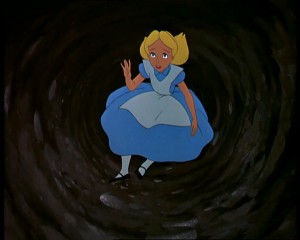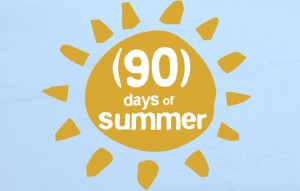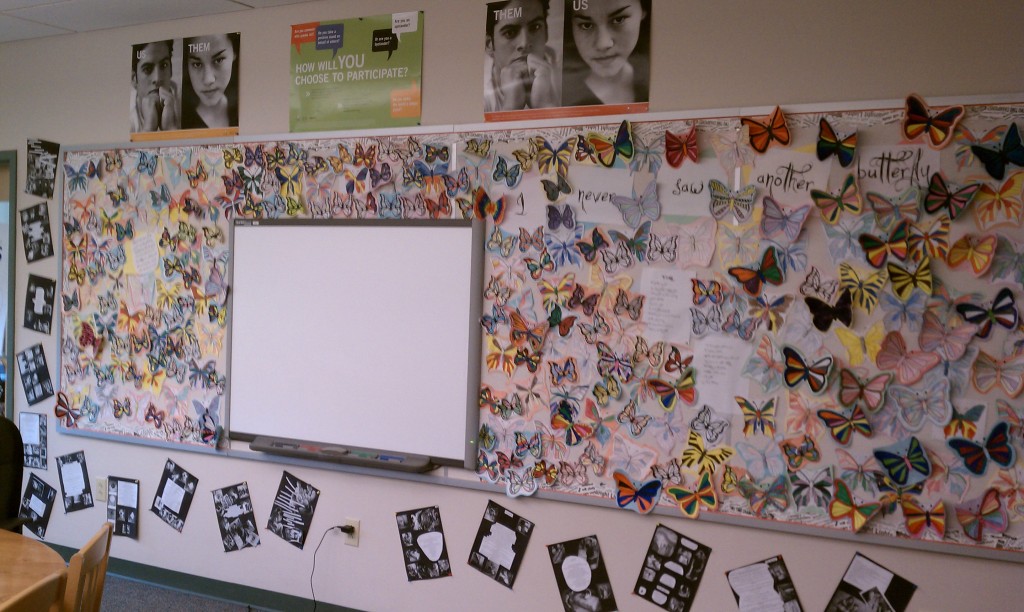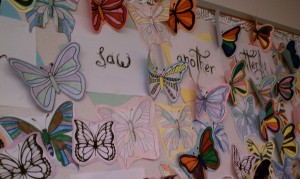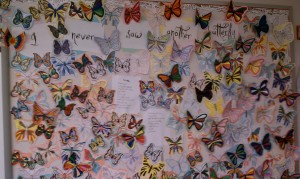It’s been a long time…I’ve dusted off my blogging skills in my new position as Director of Education at Laurel Springs School. Check it out here!
There…a message about being here.
Note: I delivered this message to middle school students a few weeks ago. I began by reading There by Marie-Louise Fitzpatrick. If you haven’t read it, I highly suggest getting yourself a copy to remind yourself of where you want to be in life regardless if you are 5, 55, or 105.
Often we seem to be at a crossroads between here and there. We are always wanting to be there…wherever there might be for you. It begins when we are just babies. Sitting and drooling becomes not good enough and we want to crawl, climb out of our cribs, or throw a fit just to get there. Once we master that and are walking and talking, we want to be like the big kids and go to school. Yes, there was a time that you couldn’t wait to start school! Then, it seems like the cycle never stops. Once you are in preschool, you want to go to Kindergarten, once you are in Kindergarten, you want to go to lower school…even in lower school all you want to do is be a fifth grader. But when you are in fifth grade, you want to be in middle school…yet, ask any middle schooler in here and they’ll tell you they can’t wait to go to high school. The 8th graders are really experiencing this right now. They have all found out which secondary schools they have been accepted to and are beginning to rule out some schools and wait on others. They are so ready to be there because they know where there is for them. Yet, in just 6 short weeks, we’ll be in Canada and they will want to be here…with their class more than anything. Eighth graders, I hate to tell you this, but you have just 12 more weeks to be…here. The funny thing is that life will move on and you will be thrust into the crossroads between here and there for the rest of your life. It will begin again in high school when you are looking at colleges, which will follow with possible grad school, travel, career, marriage, kids, career changes, and then you watch your own children go through it. I’m sure you experience this with other facets of your life be it sports, music, and even friends. It is really hard to manage everything while trying to be present…or here in the moment. Most people these days attempt to do this with multitasking. Listen to this podcast from NPR called, “Multitasking Teens May Be Muddling Their Brains”.
Multitasking – here, but not really
Now, I’m a self proclaimed multitasker. You’ve seen me…I’m a phone checker. I have three kids, work full time, serve on a community board, write a blog, I just finished grad school…even my job splits me in two between teacher and curriculum specialist. I have to admit that if I’m not doing a million things at once, I’m bored or I feel like I’m not accomplishing anything. But, I’m experienced enough to know when enough is enough. When I have down time on the weekends or vacation, it is down time…I’m talking hanging out in pjs, reading a book, going for a walk with the kids, and especially cooking. I bet most of you don’t know that I love to cook…I’m obsessed with the food channel and eagerly await my foodie magazines each month. I scour the internet and use pinterest to organize my recipes. From this creative outlet, I have started a tradition in my house on Sundays by having my parents and sometimes my sister and her boyfriend come over for Sunday dinner. Often the kids will help me cook or Reilly will whip up some awesome dessert…she’s the baker…I’m not. But, what I have found is that it is a few hours that I am guaranteed to be here…with my family. There is something to be said for the time spent and memories made each Sunday…even if we decide to have a low key spaghetti and meatballs night. I encourage you to do something you love that would normally be part of your multitasking routine and turn it into something you really focus on. It would be easy for me to microwave some nuggets, do the laundry, check twitter, and help a kid with a school project, but I make the choice each Sunday afternoon and evening to be here with my family.
When I was writing this, I kept thinking about the old saying, “the grass is always greener on the other side”. It is like we are convinced that there is always something better and what we have or where we’re at is not good enough. This is really hard when you are your age and people talk about the vacations they go on or the gadgets they have, but you know what? It’s just stuff. Stuff is replaceable and changes as you get older. The stuff you want now is not the stuff you want when you are my age…believe me. Each time you find yourself wanting something your friend has, put it in an imaginary box in your head…after awhile what will you have? A box of stuff. Maybe one day I’ll tell you about the Christmas when I was little and I got a pink townhouse dollhouse…not the grand white mansion I wanted. My parents still talk about it to this day. I didn’t get the thing I wanted, and you know what, I think I’m ok.
Speaking of parents, at this age, it is also easy to think the grass is always greener at your friend’s house. You might be convinced that your friend has the coolest parents ever and you got stuck with the meanest people on earth. Guess what…I bet your friends might think YOUR parents are the coolest parents ever….and…I bet you might be happy to have Sunday dinner with them when you are my age!
It’s not always easy to take the time to be “here” when you are pulled in a million directions or would rather be somewhere else. Here are a few things to help you be present: (adapted from this article)
- Take notice of the world around you. Find something beautiful each day and be thankful for it. It doesn’t have to be something monumental. This weekend, I had a daffodil pop up in my yard. It happened to catch my eye as I was doing a million things, but I stopped to notice this happy little sign of spring, which made me smile.
- Focus on whatever you are doing. Be mindful and pay attention with all of your senses. Try not to multitask and really focus on one thing at a time…I bet your work will improve and you might manage your time a little better!
- Smile when you wake up. Believe it or not, making yourself smile in the morning tricks your brain into positivity. If you are happy, you are more likely to want to be here than there!
- Commit random, spontaneous acts of kindness. When you bring joy to the people around you, it gives everyone a sense of being present and happy.
- Minimize the activities that dull your awareness of being here. Unplug from everything and do something active or just go outside and soak up some sun. See how long you can go before you start to twitch. And if that happens, you should try unplugging a little bit longer each day.
- Be thankful for what is. Think about what you are thankful for now…things that are already here with you. If you start wishing or hoping for something that is “there”, remind yourself to be thankful for what is in the present.
Meet Me in the Middle
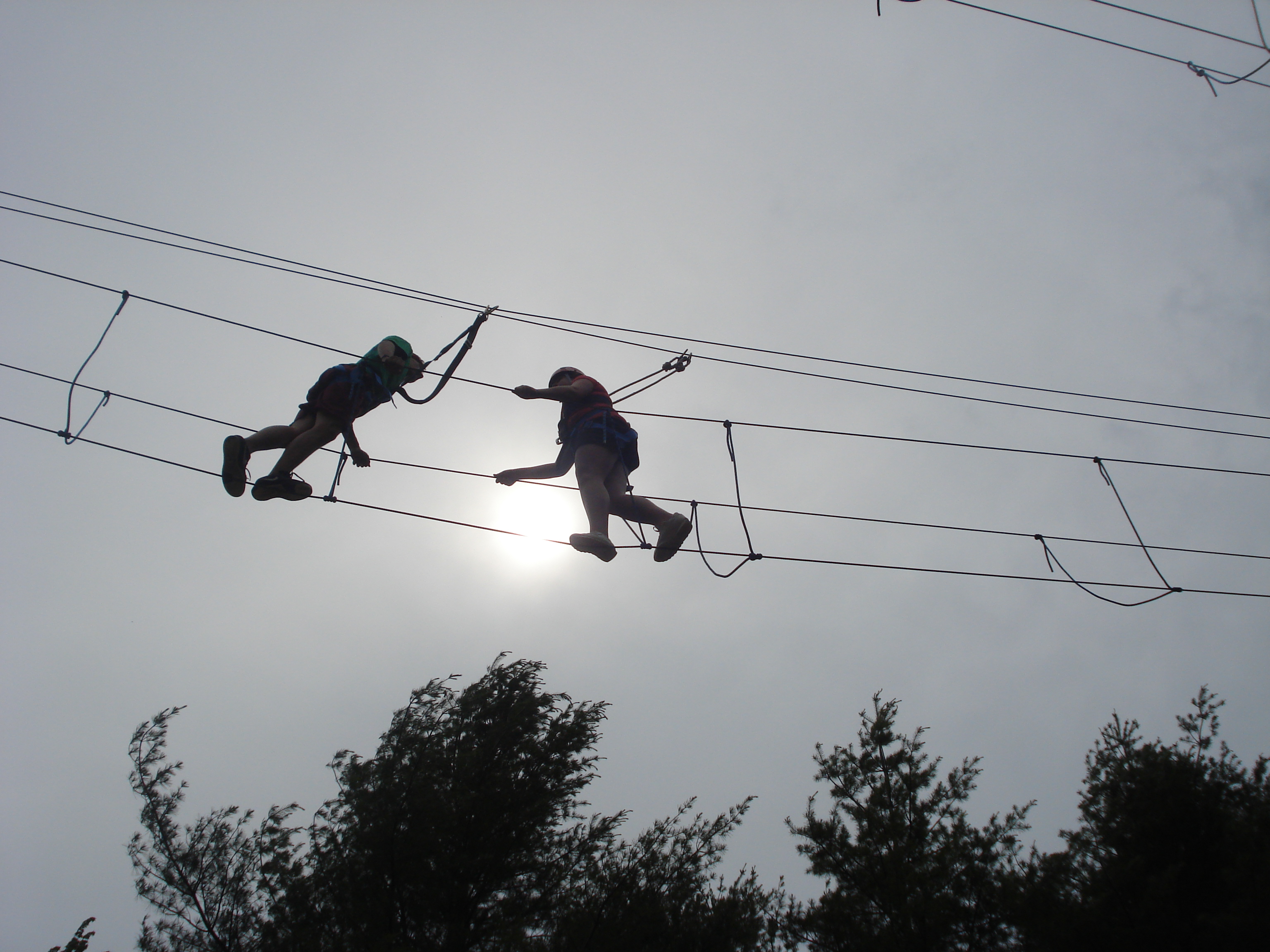
Middle School Mindset: Connecting with Students through Engagement, Trust, Respect, and Opportunities
Recently, one of my blog readers made a comment on one of my posts. I hope that she doesn’t mind, but it has been swirling in my head for a few weeks:
I am curious how you got your students to start thinking about their hopes and dreams. I find this to be a hard concept with middle schoolers. Any advice??
I was having trouble answering the question because in the 17 years that I’ve been teaching middle schoolers, I haven’t come across this situation. So I’ve been wondering why. I do ask my students to write about their hopes and dreams, their identity, where they are from, what they believe, who makes a difference to them, and I push them to think about what is right, tolerance and acceptance, forgiveness and justice, as well as broken, realized, and dreams deferred. Every time they rise to the occasion and are able to explore their truth within the walls of my classroom. How do I know this? I see them “go there” through their words, the emotion that sometimes overcomes them, and when I’m sitting in my pj’s on the weekend sobbing while reading their latest memoir chapters.
In really thinking about the dynamics of my classroom for the past 17 years, and the strong connections I still have with many of my students, I believe I have my “sentence”: She connects with students by trusting them, by respecting them, by engaging them, and by giving them opportunities to find their own truth, passions, and identity. If you haven’t written your sentence yet (or have your students write their own sentences), watch Dan Pink’s video below:
Ok, so it is more than a sentence. It is a mindset. I am from the mindset that middle school kids are people too, so I treat them that way. I value their opinions, I think they can handle tough topics, I believe in them…I respect them. I also laugh with them…a lot. This mindset has helped me create a classroom culture of respect and equality that has become integral to teaching in learning within the four walls of the room, within the school campus, and within the digital spaces we have created together. I believe in pushing them to be passionate about life and learning while taking pride in their work. It is easy not to care when you are 13. It is also easy to just cover the curriculum. When the lines of learner and teacher are blurred, both sides become invested…this give and take is the key to the middle school mindset.
A few weeks ago, two boys were arguing about how much work I give them..it went sort of like this:
Student A: Mrs. Pal, you give us so much homework.
Student B: Dude, no she doesn’t, you just can’t manage your time.
Student A: But it is soooooo much.
Student B: Just follow her little deadlines…she makes small little due dates so you don’t have so much work.
Student A: (whining noise)
Student B: It is so easy. Mrs. Pal sets it up so it isn’t hard. It’s like Mrs. Pal teaches you to walk while still holding your hand.
Me: tears (he gets it)
So how do I get students thinking about their hopes and dreams? I ask them. I share with them. And I give them the opportunity to only share with me. They are free to push themselves, but I will always be there as a safety net…and they know it. I will always meet them in the middle.
Overload. Avoidance. Balance.
or…
Where I’ve Been and What I’ve Been Up To
Combating Human Deficit Disorder
There’s Only So Much You Can Multitask
I Have a New Position…I’m Really Busy
I’ve been avoiding this blog post because I was overloaded with tech and now I’m trying to find balance.
I did it to myself. I thought blogging every day for 90 days was going to be an amazing learning experience…and it was. The problem is that it became a burden. During my Summer of Learning: 90 Days of Metacognition & PD , I did what I do best…learn something, and then share it. So here’s the problem…it was not a natural process. I found myself scouring twitter and Google Reader every morning to “find” something… anything to learn. It was fun at first, but then I found myself constantly thinking about what I could learn each day and where I could find it. I was spending more time looking for things to learn than actually learning.
So…why am I here now and where have I been? I’ve been thinking about this for a long time and it wasn’t until this morning that my friend Kami sent me a video that put it all into perspective for me. Take a moment to view it here:
I really had a light bulb moment…I had experienced technology overload, which made me avoid most social media since September. My Google Reader had the evil “1000+ unread items” for months on end. I occasionally posted a “happy birthday” to a friend on facebook. I popped into twitter for about an hour a week…a virtual space where I would spend at least an hour a day interacting on. Google+ was a black hole to me. My blog…what blog? Social Media had become more of a burden than a place where I was free to learn and collaborate, so I avoided it all. I had a new position as Curriculum Specialist, was designing new initiatives and professional development at my school, was reading a ton of young adult literature instead of the latest edu-books, and was spending time with my family. I have been truly engaged in my own world while just about shutting out the virtual world.
I’ve also been really interested in Richard Louv’s message regarding Nature Deficit Disorder. Now, I am no nature girl…I think I had zero points on Gardner’s Multiple Intelligence test in that area. But I get it. I see what getting outside does for my children…and my students. My school campus requires us to be outside to get from place to place all day long. So, for me it isn’t about picking up rocks and digging around dirt…it is about stepping away from the tech and resolving Human Deficit Disorder. It is about finding connections in the real world, but balancing connections in the virtual world.
So where does that leave me? Right now, I’m working on balance. I’m reintroducing the virtual and social media world to myself by choosing the connections that I have found encourage my own learning and sharing. I strongly believe in supporting new teachers, so I make the commitment each week to join Lisa Dabbs and Joan Young on #ntchat on twitter. This purposeful and supportive chat has helped me narrow down my time on twitter while making meaningful connections. I am in the process of scaling down my subscriptions on Google Reader in order to stay up to date quickly each morning. As for Facebook and Google+, I’ve decided they really aren’t necessary in my life right now. I’m supporting teachers in my school with purposeful technology in the classroom. I’m making great use of my Kitchen Aid mixer with my daughter. I’m playing ping pong with my middle son, and learning how to make oragami and bucky ball shapes with my youngest son. I’m reading great YA Lit and sharing my recommendations with my 8th grade students. I have given myself permission to not have to do everything, be everywhere, or try to keep up. I’m going to use my blog for what it was intended for…as a reflection of my teaching and learning experiences in middle school. It will not be a burden and I will not try to give myself time guidelines for posting. I will post when I can reflect on a teaching and learning experience that has meaning and relevance…you know…something worth sharing. It will be a natural extension of me and what I love to do…transparent, honest, and reflective.
Down the Digital Rabbit Hole
I’ve wanted to incorporate Alice’s Adventures in Wonderland into my 8th grade class for several years now. The theme for my class is Identity: Who are you? Certainly, Alice’s search for self would fit perfectly into my curriculum. I needed a perfect storm of interest and tech savvy students to experience Alice in the way I envisioned it.
This year, I piloted Google Apps for Education in my classes. My assignments became virtually paperless and I encouraged the use of Google Sites with a heavy emphasis on collaboration in Google Docs. These students far exceeded what I imagined to be possible with using Google. It became second nature to them…their “go to” tool for all written and collaborative projects. They thrived on the instant feedback I could give them at any time of day…or night. They became better writers, thinkers, and creators of digital content. This was the group that was ready to jump down the digital rabbit hole with me.
My idea for this project has morphed and changed over the course of a year and a half. It began with Christian Long’s Educon 2.2 virtual conference on using blogging with the Alice Project. I followed his students’ work and was amazed at what they were achieving, but…they were in high school…I’m working with 8th graders. So, I kept it in the back of my head until I saw a post on the English Companion Ning by Jim Burke where he was exploring the idea of a digital essay….that was it…that was going to be the vehicle in which my students would explore Wonderland! Now, I needed to figure out how to execute the reading, discussion, and digital essay process of learning.
In preparing students for high school, I need them to have a strong understanding of literary elements and how to analyze a piece of literature. It is not something easily taught or learned, but I wanted to use Alice as the opportunity to experience and analyze literature with my students. But…I needed a place to begin…a commonality..something that would grab my students…(enter Tim Burton). Before even opening Alice, I decided to use Tim Burton’s version of Alice in Wonderland to teach a little about symbolism, annotation, and themes. My students used this Google Doc to begin to look at the familiar movie in a different way. Note: I know Tim’s version is not true to the text, and I made that perfectly clear to my students…I used it for the sake of comparison later on and interest in the beginning of the unit.
If you haven’t read Lewis Carroll’s Alice’s Adventures in Wonderland, it is a difficult text to get through although it is considered a children’s story. I made the executive decision to just focus on the first book, and not Through the Looking Glass due to the level of difficulty in analysis for 8th graders. In order to ease the text reading experience, I used a combination of The Annotated Alice and the audio version played through my smartboard. My students would listen, follow along in the text, and take notes on a Google Doc entitled: Exploring Literary Elements Through Wonderland. I designed this document using the principles from Smith & Wilhelm’s Fresh Takes on Teaching Literary Elements. I wish I had video of this part of the project…students were actively reading and engaged in the text. They were listening and then following the annotations in the text while noting their own analysis in Google Docs. I was asking them to look at literature in a way they were not used to, but they took the challenge by choosing a character to focus on, noting setting as physical, temporal, & social/psychological, examining third person limited omniscient point of view, searching for themes and big pictures, and finding sense in the nonsense of Carroll’s poetry. My students became literary detectives…searching for meaning and clues in the text…they were analyzing literature!
The next part was really driven by my students. They wanted to watch the movie they were so familiar with. They sat and watched (and sang along) as they looked for similarities and differences between the text and the movie using this Google Doc. I would laugh as they would yell at the screen that a part wasn’t in the book or the movie wasn’t following the text! Some students even had the text in front of them as they tried to follow along.
I decided to make their final project…a digital essay…their final exam. I gave them the assignment 2 weeks before the final and allowed them to prep for it in any way they needed to. The digital essay is outlined here. On the final exam day, they would have an hour and a half to compose their essay on their individual pages within the Google Site for the project. For most, it meant they were putting together pieces they had been working on for the past two weeks. Preparation was the key to pulling this off in a short time period. What I got as a final product astounded me…I had pages of items that looked and read like Wikipedia entries that were dynamic visually with images and video. The pages made note of references for books, movies, images, and video. My students did it…they learned how to analyze literature, movies, and created a digital essay to authentically express their knowledge.
Click the image below to go to our class digital essay Google Site:
Click below to see an exemplary digital essay from the project:
Now it is time for me to reflect on this project. I want to take what worked best and improve upon it next year, and I want to examine potential pitfalls with upcoming classes. I’m excited to see how next year’s class will approach learning in the digital rabbit hole!
Mapping My Summer Learning in 90 Days: An Experiment in Metacognition & PD
You know the old saying…teachers teach for 3 reasons: June, July & August. This statement has always infuriated me. As most teachers, I believe I work with an incredible intensity in the summer months. The time off from school allows me to regroup my thoughts, reflect on lessons taught, learn new things, read … a lot, attend conferences, and learn for the joy of learning. These months provide the fuel I will need for the next year and inspire me to challenge myself and my students.
Recently, my position has changed to a more administrative role in curriculum. Luckily, I will still be teaching, but I am now responsible for professional development, curricular initiatives, individualized teacher support, and a new mapping initiative. Our first attempt at mapping a few years ago did not go as well as planned and it was abandoned. Three years later, I have been thinking about how to make the process of mapping manageable and purposeful to the faculty. I think I’ve got my answer…but that would require a lengthy blog post, so let’s just leave it at…I’ve been thinking about mapping and learning a lot.
June 1st arrived and I was thinking of the significance of that date. I wanted to find a way to document my learning experiences over the summer so that I could use it to share my summer professional development. I decided that I would map my learning for 90 days. I would choose one thing that really stood out to me each day and explore what I learned, my learning path, and further learning. I will consider my Google Reader and Twitter accounts as my true maps of daily learning, but I want to document those things that push me to think differently, encourage me to research, facilitate discussion, and truly give a glimpse into my professional learning experience.
You can follow along with me this summer as I map my learning for the next 90 days here. I’d also encourage you to do something similar….think about what you’ve learned every day and do something with it…embed it, share it, talk about it. Reflect on your learning…it’s what we ask our students to do every day. Be a student this summer for yourself, your colleagues, and your future students…create the kind of professional development you always talk about, but never seem to have time for.
Everything I learned about teaching middle school I learned in 1st grade….
….or passion+projects+technology=engagement
…or those first grade teachers are on to something!
…or teaching is a skill, not a content (or grade level for that matter)
When thinking about pairing projects and technology in my lessons, it actually isn’t even a thought. It has become such a natural part of my lesson design that my students, parents, and administrators expect it. This is not something I was taught in college…it is a mindset that was fostered during an amazing student teaching experience. Believe it or not, I student taught first grade. I was positive that I wanted to be a lower elementary teacher who could inspire the kids at the very beginning. My cooperating teacher, Kathy Horstmeyer, was the best of the best. Her classroom was not traditional…there were no desks, lots of noise, and the room seemed to transform into ponds, space, jungles, or whatever the theme of the week was. Students were always actively engaged in small learning groups, thematic projects, and thoughtful reflection of their learning…at a mere 7 years old. This is where I learned how to be a teacher. This is where I had a sense of how passion, projects, and technology could transform a classroom.
From this experience, I was asked to interview for a middle school position within the district. The thought absolutely terrified me! Of course, I got the job and began my own teaching journey as a 21-year-old teaching 7th graders language arts and social studies. The way that I conquered my fears in those early days is the reason I am the teacher I am today. I consciously decided that I would take what I learned from teaching first grade and apply it to 7th grade, but just at a higher level. I planned my lessons to be cooperative, project based, reflective, as well as infused with whatever technology I had at the time. I was going to replicate that feeling of passion, learning, and excitement that I witnessed in first grade… in my middle school classroom. You know what I found out? Those first grade teachers were on to something! Middle School students completely disengage when taught in a more traditional manner…they are kids who are passionate about different things, who are exploring their individuality, who enjoy collaborating, and who use technology as we use a pencil. Early on, my goal became to learn as much from my students as they learn from me…16 years later, it still is. Passion based learning and technology have allowed me to be a guide within the classroom directing students, and figuring out how each student learns best.
Personally, I think every student teacher should have to teach first grade. They are the masters of differentiated instruction, project based learning, student centered curriculum, integrated instruction, and use technology to enhance learning on a daily basis. They are modeling the 21st Century Skills of creativity and innovation, critical thinking and problem solving, as well as communication and collaboration. Go ahead…hang out in a first grade classroom…you’ll see…those first grade teachers are on to something!
So, what’s on your wall?
A few weeks ago, I received an email from Teaching Tolerance with a subject line that read: What’s on your wall? I opened it and read the following:
Every classroom has a personality. You can often see it just by walking in. The doorway, walls, and bulletin boards are all decorated to let students know the teacher cares.
Many educators work hard to create that just-right presentation. They know decorating classrooms is an art form. We know it, too. That’s why we’d like to recognize the teachers who do it well. We’re planning to show some of the best classroom decorations in the 20th anniversary issue of Teaching Tolerance magazine, coming out this fall.
Send us photos of your classroom decorations. Keep in mind that we’re looking for themes tied to tolerance, such as civil rights, bullying, racism, women’s issues, fighting stereotypes, religious freedom, economic disparities, disability and sexual orientation.
I didn’t even have to think twice about this. I immediately went to the butterfly “wall of hope” in my mind. For the past three years, I have been teaching Holocaust Studies to 7th graders in order to incorporate tolerance and acceptance into the curriculum. Through literature, short stories, film, and multimedia, my students explore the essential question of: What is Right? throughout the year. In order to teach remembrance and memorial, I use the film Paperclips (2004) to show how a group of students not only learned about the Holocaust, but also created a memorial that would change their lives as well as the lives of the people in their small, rural community.
After watching Paperclips, I read “I Never Saw Another Butterfly”, written in 1942 by Pavel Friedman.
“The Butterfly”
The last, the very last,
So richly, brightly, dazzlingly yellow.
Perhaps if the sun’s tears would sing
against a white stone. . . .Such, such a yellow
Is carried lightly ‘way up high.
It went away I’m sure because it wished to
kiss the world good-bye.For seven weeks I’ve lived in here,
Penned up inside this ghetto.
But I have found what I love here.
The dandelions call to me
And the white chestnut branches in the court.
Only I never saw another butterfly.That butterfly was the last one.
Butterflies don’t live in here,
in the ghetto.Pavel Friedman 4.6.1942
After discussing the film and the poem, my students decided they would like to take the symbol of a butterfly to represent hope for the 100 surviving children in the Terezin Concentration Camp. That year, they created 100 butterflies and put them on my wall to represent hope, tolerance, and remembrance. The following year’s students continued to add to it to create a wall of hope using the symbolic butterfly. Again, this year’s class wanted to add to it. I don’t know how many there will be, but it has become an integral part of my room. Often, people who just see it think it is a pretty display, but one of my students will be quick to explain the true meaning behind the hope and remembrance. My students are taught to be upstanders through tolerance and acceptance, and this wall is representative of just that.
Extra, Extra…read all about it!
7th Graders Hit the Press with Special Editions about Power and Control!
So, I’ve been MIA. I haven’t been lazy or unmotivated, I’ve been piloting a Google Apps program in my 7th and 8th grade classes. My next post will detail my amazing experience teaching and learning in the Google cloud. For now, I’d like to highlight a favorite collaborative project done completely in Google.
Tolerance and Acceptance drives the 7th grade curriculum. My essential question for the year is What is right? Tolerance and Acceptance is explored through Power and Control, Belonging, and Lessons from the Holocaust in literature, writing, poetry, journalism, and multi media. I chose Animal Farm, by George Orwell to discuss the implications of absolute power and individual control. My students actively read, had heated discussions, and wrote blog posts from the point of view of a character. These are usual occurrences in my classroom when we analyze a class novel…but my students were so engaged that I needed to give them an alternative outlet for their learning…
In thinking about the novel…a fable…I glanced down at my Kindle edition and saw “Animal Farm: A Fairy Story”. I began thinking of fables, then saw the word “fairy”, which brought me to…you guessed it…fairy tale. In my very first year of teaching (16 years ago), I did a fairy tale journalism unit where students worked collaboratively to produce an over-sized newspaper based on a fairy tale. I knew I wanted to adapt this project for Animal Farm and bring it into the 21st Century! Google was the key to doing that!
While designing this project, I thought back to the elements that made my original project successful…creativity, writing skills, and collaboration! Who knew that Google docs, Google presentation, and Google sites would come along to incorporate those original elements from 16 years ago. Before I even introduced the technology aspect of the project, students needed to learn the components of a newspaper, how to write a newspaper article, and what makes a good story. Once I established that, I could get into the nitty gritty project details.
I envisioned a digital newspaper that was created collaboratively with all of the original elements from my fairy tale newspaper which included: newspaper name, lead story, an individual article from each member of the group, editorial, letter to the editor, advice column, comic, and 2 advertisements. The project details can be found here along with detailed writing instructions here. I also provided some extra credit opportunities to add to the group newspapers, which the kids had a ball with! Students were able to work collaboratively using Google presentation and Google docs. They wrote and edited articles in docs and put together their newspaper in presentation. With these Google applications, I was able to “see” who was working on their articles, editing their newspaper, and collaborating in the cloud. This allowed me to be present in each group…even if the group was working at home! This has been a teaching game changer for me. I no longer have to worry if one student did all the work…I can see it with a time and date stamp, a revision history, and a collaborative chat window. I found this has made students more willing to own their work…and be a responsible group member. Although I had this access, I still created a Google form self/group evaluation survey that I used in assessing their project.
While planning the newspapers, I knew this would be a perfect opportunity for a multimedia component to the lesson…a newscast! I will say this…my 7th graders are not shy…they love making videos…and had no problem dressing up as cows, farmers, and reporters! With flip cameras, smartphones, and apple technologies, my students far exceeded my expectations for a newscast. I honestly wanted them to have fun with their newspapers by presenting it in a creative way. What I didn’t realize was how drawn they are to multimedia and how skilled they are in producing it! All I told them was the newscast could be live or video…they were the ones who created story boards, added special effects, used editing software, put in credits…as well as the all important bloopers section! We spent two classes completely engaged in their self produced newscasts!
In order to share all of the collaborative projects, I put together a Google site with all of the newspapers and newscasts from both sections. I won’t be sharing that here since there are student videos, but I will share a few of the completed digital newspapers. This site has allowed me to create a live portfolio for other students to learn from. I can’t wait to see what next year’s class comes up with!
Fostering Thinking, Creativity, and Digital Citizenship Through Blogging
I have been blogging with my students for the past three years. It has grown and changed in purpose since I started. I use a secure blogging site for classroms called 21classes, which ensures the privacy that I wanted for my 7th and 8th graders. Originally, the blog was used as an online notebook for logging reading, creating journals, and posting assignments with an occasional discussion or two about a novel. I quickly saw the power of using the blog to pre-discuss questions before class. When my students were allowed the time and structure to pre-think what they were going to say online, I found they were more prepared, engaged, and willing to participate in a discussion during class.
What my blog was lacking was the interactivity created between a blogger and an authentic audience. Since my blog is secure, I needed to be able to have students be that audience. But what would they comment on? I had tried creative writing and journaling in the past on the blog, but it never seemed to be something that sparked a conversation. Once I read Jim Burke’s What’s the Big Idea? this summer and had a conversation with a colleague, I knew what I was going to do. If I used Jim’s Big Questions in the back of the book as blog post ideas, I would be putting students in a position to answer a question by creating a conversation. Each week, I require students to pick one of Jim’s Big Questions and write a 2 paragraph post about it. They can respond by simply answering the question, creating a narrative story about the question, connecting the question to current events, or using a real life example to make a connection. Some examples of the questions are:
- When do you feel most free?
- Why do we sing?
- When is it better not to know?
- Who is the real you?
Once I established the blogging assignment, I needed to focus on the digital citizenship aspect of commenting. Believe it or not, there is not much out there about teaching commenting skills. I came across this guest post by Kathleen McGeady on the edublogger about teaching commenting skills and etiquette. This was exactly what I was looking for! I adapted her guidelines for my classes and created “How to Comment on a Blog Post”:
How to Comment on a Blog Post
- Write your comment like a letter by including a greeting, content and a closing.
- Always use correct spelling, punctuation, grammar and spacing.
- Compliment the writer in a specific way, ask a question or add new information.
- Write a relevant comment that is related to the post.
- Do not leave a comment like, “Cool post” or “I like ur blog”. These comments are not conversation catalysts.
- If you have a differing opinion than those of the poster, be positive in your delivery of your comment. You can say things like, “I appreciate your post, and you made some good points, but I think….” or “I enjoyed reading your post about school uniforms. I can see why many parents and students would like uniforms, but I like to express myself through my clothing….”
- Always read over the comment and edit before submitting.
- All of your comments will be submitted to me before posting. Any comment that does not follow these instructions, or is negative or mean spirited will not be posted. These types of comments can result in being blocked from the blog, which will make completing homework a difficult task.
Dear Susie,
I really enjoyed your post about what your name means to you. Do you think that your parents named you for those reasons as well? To me, my name is my identity. It doesn’t matter if it came from my Aunt Sally. Sally, to me, is a soccer player, a sister, a good friend, and a person who loves her friends and her family. It isn’t just a name…it is me. Thank you for making me think about what my name means to me.
From,
Sally
Here is an example from one of my 7th grade classes:
Blog Entry #3: Why should we keep trying?
Why should we keep trying? I think that this is a very important question to ask ourselves . I think that we should keep trying during tough situations and when we are trying to reach a certain goal. Trying is very important. If you try hard and never give up, you can achieve almost anything you set your mind to. Trying almost never fails you to reach your goals and get you out of situations. If you try hard in all that you do, you will probably succeed. If you fail your test, try to learn your mistakes. Try to understand it better and see what you can fix in the future. If you try hard, most likely you will succeed.
Trying hard is very important in life. For me, I try hard to earn good grades to go onto my high school application. If I try hard and get good grades this year, my high school application will look nice. It’s the same with any new sport or instrument you play. If you try hard, you will get better at it whatever sport or instrument you are playing. I’ve been playing piano for 8 years now and I try hard to play more advanced pieces. I’ve played softball for 2 years. I’m not the best pitcher, but I know that if I just keep trying, then I will be able to pitch more accurately.
Whatever you do, keep trying. You have to push yourself to never give up until you reach your goal. Keep trying when you are in difficult times. You know if you try hard, then you will be able to stick it out to the end. So try, try, try!Dear Student X,
I thoroughly enjoyed your piece on why we should try. I think you bring up some valuable points. What is the most advanced piece you can play on the piano? I have also been playing an instrument for a large span of time, and I know that trying is important in music. I also try to get good grades for high school. Keep it up!
Your Friend,
Student Y









